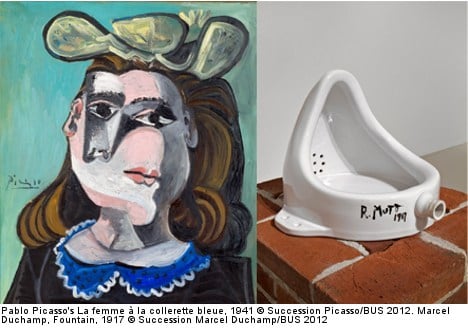He hasn’t come back alone. Claes Oldenburg, Verner Panton, Walter Pichler, Robert Rauschenberg and Ed Ruscha are among the 90 plus artist and designers in the retrospective. It details in length the interplay between new materials in the post-WWII era and how it affected consumption and art. Warhol and co were hard to ignore at the time, and indelible today.
“We are in a post-Warholian paradigm in art production,” Moderna director Daniel Birnbaum told The Local.
“People can pretend we haven’t passed through that period but I think that is either naive or a little bit reactionary.”
One part of the exhibition, which is divided into a slightly overwhelming 22 themes, is dedicated to women in pop art. Both the ridiculous – a woman’s body contorted into the base of an arm chair, and the ridiculous in another way – Warhol’s Brillo washing powder boxes stacked in a corner like washed-up treasure.
“Mass culture had a very strong influence on culture, with images of the happy housewife, and the sexualized female body,” co-curator Matilda Olof-Ors told The Local
She walked over to a painting on a side wall. It depicted a beaming woman throwing away trash, with the slogan ‘nine out of ten’… a parody of the epoch’s advertising tactics – as in ‘nine of ten housewives choose this or that detergent’.
“Lee Lozano takes the language of commercials – the ‘nine out of ten’ line which was used over and over again,” says Olof-Ors, before pointing at the painting’s punchline at the bottom.
“‘Eat cunt for mental health’… It’s a brilliant comment which I couldn’t resist including.”
Pop art has suffered critique that it’s superficial. Moderna Museet director Daniel Birnbaum disagrees, referencing the contorted woman’s body serving as a chair.
“It’s clearly something ridiculous, it commodifies a woman into a piece of furniture,” he told The Local.
Birnbaum underlined that even Warhol tried to shirk away from claims he did anything more than reflect the times.
“He loved life, he loved modernity and it would be meaningless for him to say ‘I’m against it’,” he said.
“But you don’t paint the electric chair or traffic accidents in a celebratory mood, you don’t, and Andy Warhol is a more complex person than that.”
“You can’t say pop art is only descriptive or neutral. It also makes clear ideas in the viewers’ own mind without being over critical in an over pedagogical way.”
The juxtaposition in one of the art pieces on show appeals to co-curator Matilda Olof-Ors. It’s her favourite in the exhibition, a Marlboro Man cowboy leaning leisurely against the museum wall. Conceived by Jann Haworth (who will speak about her work and Pop Art in English at Moderna on September 20th), he’s made of foam.
“He’s a macho guy and he’s soft,” Olof-Ors said.
Ann Törnkvist
Mathias Schwartz-Clauss and Matilda Olof-Ors co-curated the exhibition which is a cooperation with the Vitra Design Museum and the Louisiana Museum of Modern Art.
Pop Konst Design runs from June 29th to September 22nd 2013.



 Please whitelist us to continue reading.
Please whitelist us to continue reading.
Member comments